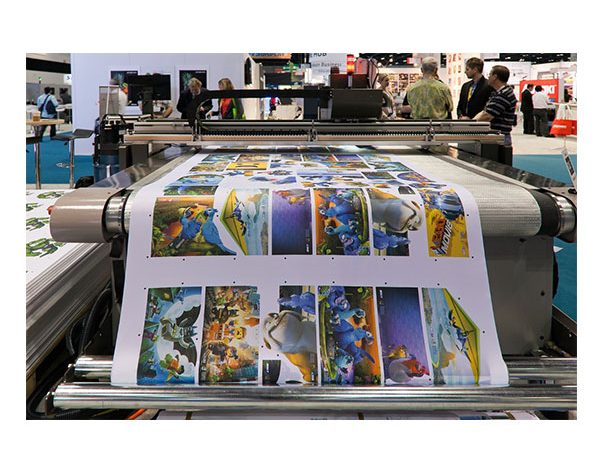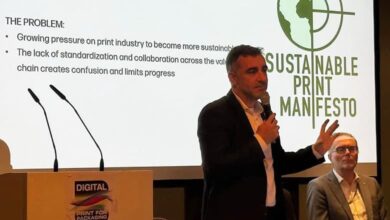
Be it physical or online – drupa will further strengthen its pre-eminent position as the ‘Olympic Games’ of Printing, while at the same time highlighting the convergence of markets. In any case, the Düsseldorf trade show has not been limited to just commercial printing for a long time. The arrival of digital press manufacturers, and the successive expansion of their stands have already shown this.
Today, in addition to printing in the classical sense, other areas are growing: exhibitors are offering 3D printing machines that do not “print” colours or texts to surfaces, but instead print in 3D shapes. Gutenberg must be rolling over in his grave! Erez Zimmerman, the CEO of ‘Massivit 3D’ and specialist in large-format 3D printing, once told us at a fair in Munich: “We will surprise drupa with new products and innovations”. Undoubtedly that leaves us wondering what the relationship is between the creation of a 4-colour brochure (what the traditional show audience is looking for) and the production of a giant bottle of champagne for decoration at the point of sale. Is a giant bottle of champagne (among other things) of any interest to the traditional show customer? Obviously yes. This is a sign of visible, immediate and undeniable convergence.
Digital printing has certainly transformed the print world. For a long time, it was restricted to printed documents and photocopying, then inkjet went after the label market first, followed by the narrow width packaging market or “small” format. At the same time, in the world of large and very large format, inkjet pushed the screen printing and even the offset process out of the most common jobs.
Over the past few years, there has been a kind of mantra that has spread like wildfire- ‘Markets had to converge or would be forced to. This convergence would lead to a spectacular evolution!’ This of course is neither totally true nor totally false.
The decline in the traditional commercial offset printing industry has led printers to expand their range of business offers. Those who printed periodicals have squeezed costs, while others have managed to survive, thanks to the catalogues that the big supermarkets threaten to eliminate on a regular basis. Those who were doing brochures had to find new opportunities. The ‘transpromo’ or ‘document printing’ which were already exploiting the possibilities of digital for variable data, had their specialty companies. These were often developed out of what was previously known as continuous printing. There was no question of going on their turf. Consequently, we had to move on to other niche products. The simplest thing to do was to develop additional service activities such as labelling or signage.
The difficulty of expanding its business
It goes on and on, but let’s not kid ourselves, it’s still a back-up for these printers, except to step up and get heavily equipped.
The cost of investment is a hindrance, but it is not always the most important. There are at least two others, one concerning the equipment and the other concerning the people.
In order to expand your business, you can buy a digital press at an inexpensive price. Without having to store its sheet-fed offsetters, a printer can afford an entry-level, narrow-width toner press to make labels at less than 40,000 euros and even less for some low-performance models despite the already high quality for prototyping or ultra-short series. In order to move up to the higher dimension, you will soon reach half a million euros, which is no longer the same game. But above all, you can’t produce very sophisticated labels that require expensive finishing tools without quickly reaching the same half million benchmark.
Then there is human resource toll, where digital technology has erased the machine operator’s know-how, putting it on the pre-press, but has not erased the finishing expertise that will make all the difference.
It is fine to make labels, but you still have to have a market! And most commercial people are by nature, very traditional. The person who has built up his business base by knowing all the brochure buyers must start all over again without abandoning his basic profession. This is not a question of giving away the shop for a sixpence to renew its interlocutors. It’s not impossible, but it takes time, so it is an additional investment. Some people think they can get away with it by becoming a subcontractor. They recover their business and run their presses, but this is often in disregard of their margins.
Recently, at a round table held in Lyon, we were talking with Robert Tison, a printer in Isère (Imprimerie Suquet), who has developed the printing of labels from a commercial printing business to buying a medium-range toner press. After starting out modestly to serve his customers, and to avoid losing them, he acquired the skills that led him to believe that this business would allow him to grow despite the decline in traditional printing. He realized that the hardest part was right in front of him. “At the beginning, we get orders and then, by word of mouth, we develop even more. But to move forward, you have to get organized and invest, even reasonably, and that’s where it becomes difficult, because you have to commercialize it.” This requires either changing gear from being a printing manager to becoming a sales manager or hiring a sales person and generating additional expenses.
We could say that this is unique to this sector, but that is not true. Of course, the development of flexible packaging has given ideas to many label printers. For example, some small pouches can be produced on label presses. Several printers that were interested in this possible development quickly realized that this required different finishing materials – unless you deliver webs of undone pouches. Furthermore, their loyal customers who trusted them with labels were not buyers of these new references that they were offering. Also, it is important to recognize that it seems to be the same situation for flexible packaging converters – as they do not venture into the label industry even if they have the technical capacity. Constantia has recently focused on flexible packaging by merging its labels division with MCC, without any hesitation.
Web2print pushes for convergence of markets
In fact, the idea of convergence of markets comes mainly from manufacturers, especially digital, but not only with the example of Mark Andy or Omet who now offer flexo presses in 450, 550 or even wider. The idea also comes from web2print. The multiplication of references on the sector’s sites, whether B2B or B2C, supports the idea of convergence.
Visit Online Printers in Neustadt-an-der-Aisch, close to Nuremberg. They can do anything with their arsenal of conventional and digital presses. If they can’t do something, they can easily outsource it. It is the same for other international groups such as Cimpress, or more regional as Printoclock in Toulouse, for example.
Printoclock started as a pure player, with no own printing but with a finishing-cutting workshop – amalgam is the web2print solution dedicated to reprography. They then developed a large-format activity by integrating roll2roll presses to make tarps or posters. Isn’t that convergence?
In Honfleur, Xavier Rozé, head of the Marie Printing Company (Imprifrance Network), traditionally specialized in brochures, equipped himself with a 1.60m cutting-printer after hesitating to get into the label business. It now meets many local needs allowing it to run the shop. However, developing a “large format” activity is not as easy. This often requires having control of the installation: wrapping a vehicle is not that simple, nor is wrapping a store counter. This is what makes web2print sites so successful. They are exempt from marketing because there is an internet site functioning as a self-service as well as from implementation since once the order is delivered, the site has fulfilled its mission. Let’s not forget that payment made when ordering which is even better!
To conclude on large format, we can see the evolution of the materials used, with the search for the simplest possible implementation. We can also see the birth of recycling constraint. The PVC tarp gives way to the textile one, and in a curious mix of genres, decoration tempts the pros of signage. You then have to equip yourself in roll-to-roll when you are in flatbed, or vice versa. There is also a choice between direct printing (for vinyl) and sublimation (for textiles). However, this requires significant investment for companies that are often large small businesses.
To wrap it up, regardless of the business, specialized printing has good days ahead of it, as it is not easy to diversify. It is undoubtedly easier to remain faithful to one’s basic business, to extend it to its maximum and above all to seek productivity gains. For this reason alone, there is nothing like being on the lookout for innovations. virtual.drupa will have a lot of them in store.
By: Jean Poncet







2 Comments